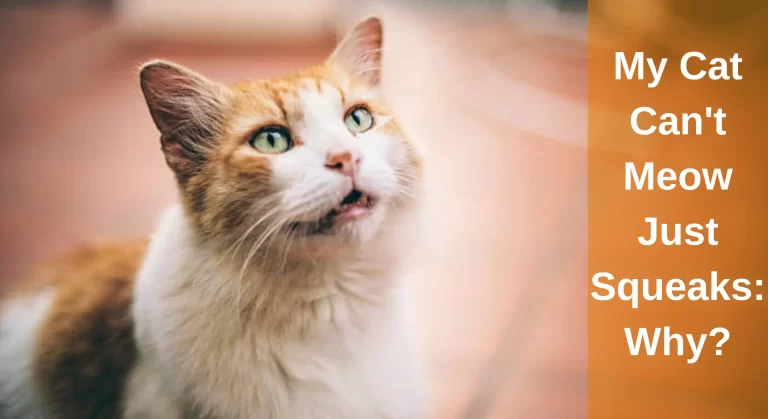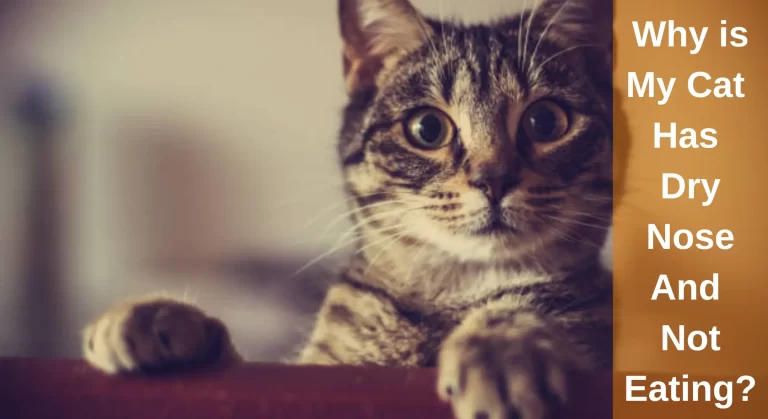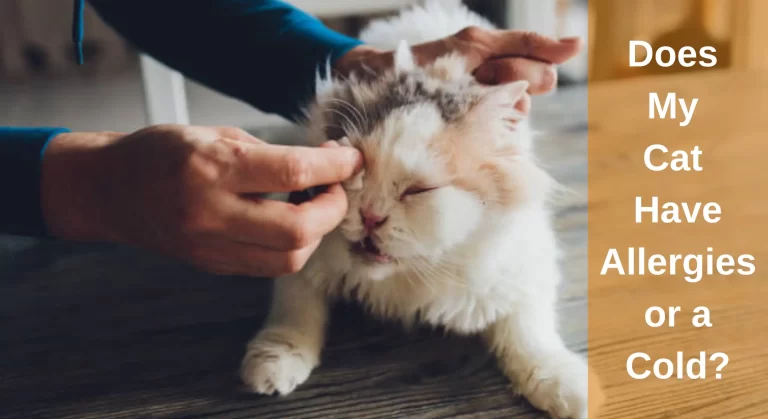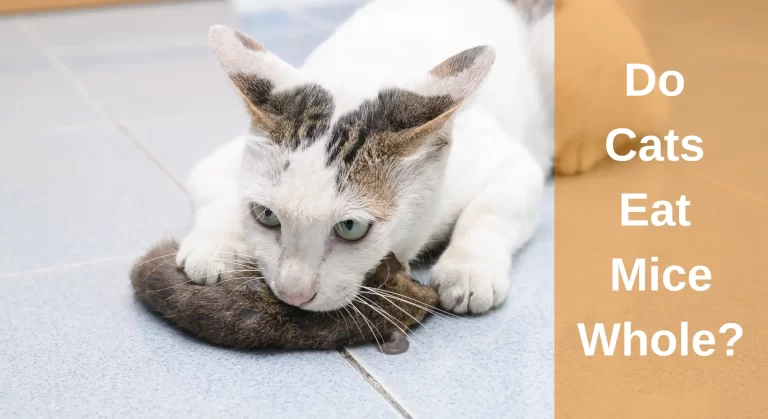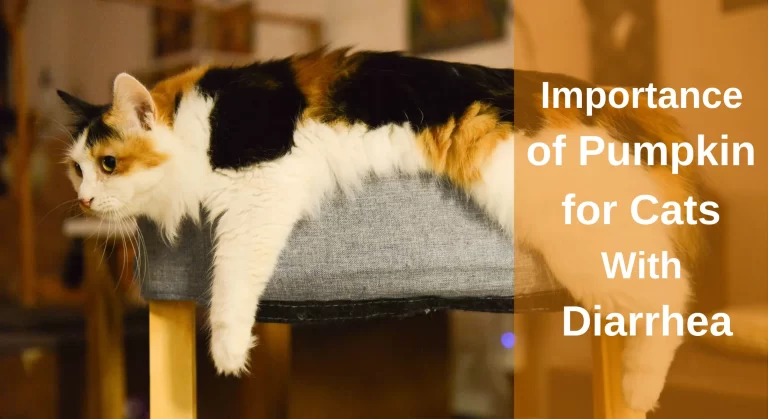Wood Pellet Cat Litter-Is It Safe?-What You Need To Know
With biodegradable, eco-friendly cat litter now available in the market, it seems to be all the rage these days. Some cat owners even claim to buy equine wood pellets made specifically for horse bedding, as it is kinder on the wallet. This leaves a very important question; are these wood scrapings derivatives safe for your feline? Is it safe to use wood pellet cat litter?
Because the toxic component, phenol, is removed during manufacturing, wood pellets are 100% safe for your cat. My favourite thing about wood pellet litter is that it does not track! It is environmentally friendly, cost-effective, smells much better, and is easier to manage.
The use of wood pellets as an alternative to clay cat litter is becoming more and more popular. You can use the information in this article to decide on the ideal litter for your beloved feline.
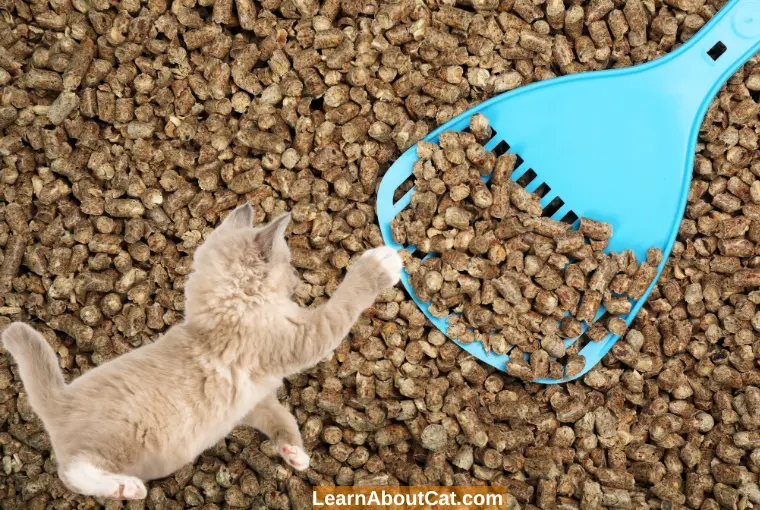
Is Wood Pellet Cat Litter Safe for My Cat?
Of course, our feline’s health is our utmost priority, and kitty litter greatly contributes. This is because traditional litter has a dust factor. It spreads and clings onto your cat’s fur and also on its paws.
Your cat ingests it while cleaning itself and also inhales it while using the litter box. Inhaling fine grains can cause allergies, and ingesting litter in excess can be harmful due to the presence of sodium bentonite in clay litter.
Wood pellets have no dust factor. When moved around, it does not create a dust cloud like clay litter, so it saves you and your feline from allergies. Not only that, if your cat accidentally ingests a pellet, it is not a choking factor as the pellet will break down to sawdust and simply pass through your feline’s system.
The only concern that some cat parents have is with phenol in pine wood. Phenol is a compound that gives pine wood its distinctive scent. However, during the pellet-making process, phenol is completely removed from the pellets, making the product absolutely safe for your feline.
Also Read: Are Pine Pellets Safe for Cats? Things You Need To Know
Can You Use Wood Pellets for Cat Litter?
Pellets for livestock feed are a simple replacement for traditional cat litter. In actuality, there are a variety of reasons that encourages you to use wood pellets in your cat’s litter box. Following are some causes due to which cat owners prefer wood pellets:
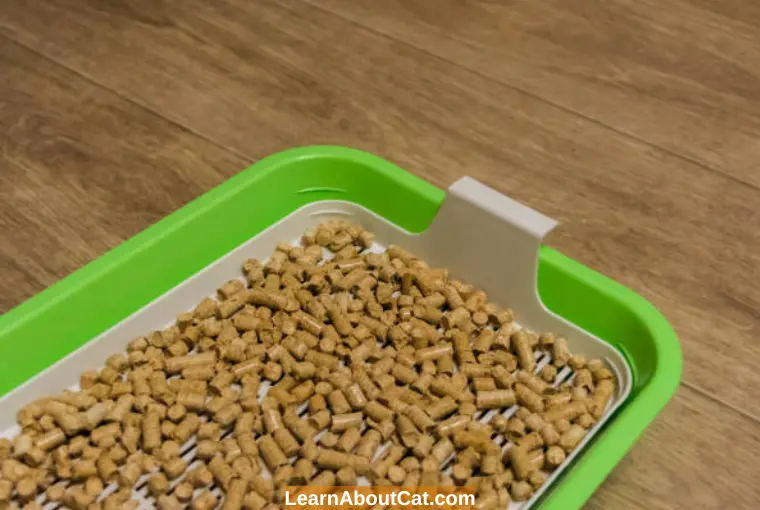
Cat’s health. To keep his paws tidy, your feline licks them. He can experience unpleasant stomach complications if he consumes litter clumps while performing this action.
Environmentally friendly. Since wood pellets can be recycled and biodegraded, they are considered a green alternative for tiny boxes.
Odour reduction. Sand does not suck up smells of cat litter, which makes your home’s environment foul smelly, and uncomfortable for you and visitors. The aroma of wood pellets is clean and woodsy. They can absorb the bad odour of your cat’s litter box and makes the environment clean.
Lightweight wood pellets. As you know, sand is heavy, so cleaning the cat’s litter box can be a real hassle. On the other hand, if you put lightweight wood pellets dissolve into light dust when it gets moistened, it will help you easily lift the litter box’s weight and easily clean it out.
Pellets of dirty wood can be recycled. Clay waste needs to be disposed of. However, dirty wood pellets b recycled and even decomposed. Home waste is decreased as a result. The ashes of dirty wood pellets can also be used to improve soil productivity.
Reasonably priced. Wood pellets are a less expensive option for your kitty litter requirements as compared to other sources, such as sand.
Pellets made of wood are simple to discard. You can easily scoop out the faeces from the wood pellets and throw them in the bin. Pellets that are moist will decompose and become debris.
Do Cats Prefer Wood Pellet Cat Litter?
Although wood pellet litter has many advantages, cats do not like it initially. Cats are biologically ingrained to make a hole, excrete their waste and cover it up with dirt. Wood pellets are not fine-grained like dirt, so this type of litter has a definite learning curve.
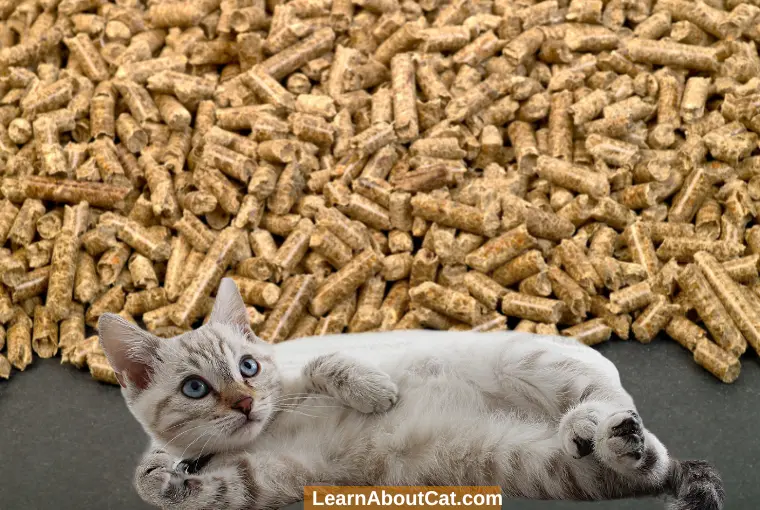
However, some cats love it once they get used to wood pellets. Not only are the grains softer and less coarse like the grainy clay litter, but it also doesn’t adhere to their paws, and we all know how much cats love to keep themselves clean.
Check Out: How to Keep Cat Litter Off the Floor?
How to Use Wood Pellets for Cat Litter?
If you wish to switch from conventional sand litter to wood chips, you should do the following actions. If you switch too soon, your cat may become confused and have “mishaps” where they shouldn’t be.
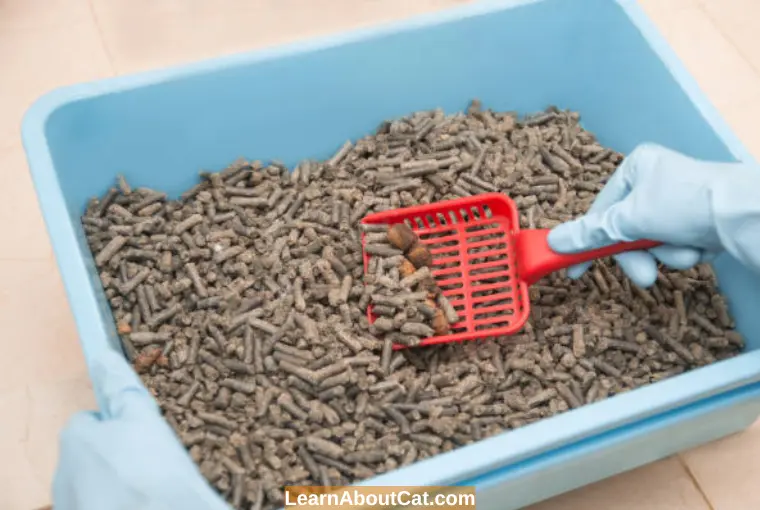
1. Step 1: Buy a New Litter box
Providing your feline with a choice involves gradually switching to wood pellet bedding. You may provide two cat boxes: one filled with brand-new wood chips and the other with conventional sandy litter.
2. Step 2: Add Wood chips to the Litter box
But put only around a half inch of wooden pellets in the litter box. Now put the litter box in a location where your feline frequently visits. Remember to sprinkle baking soda over the wooden pellets, which will help reduce litter odours.
3. Step 3: Transitional boxes
Your cat will use the wood pellet litter box without any assistance. But if not, you must try some cunning tactics to get your kitty to utilize this wood pellet box.
For this purpose, add 1 cup of dirty litter to the fresh wooden pellet. This will familiarize the scent of the litter box and draw your feline to use this new box.
When you refresh the litter every morning, remove some of the sandy litter and put a couple of extra wood pellets, around 1/4 cup, into the litter box.
4. Step 4: Replace it
Now remove the sandy box and allow your feline to utilize only the wood pellets; when your feline is adjusted properly to the wooden pellets box.
It’s critical to keep a close eye on everything. If your cats feel uneasy with the wooden litter box or stop using it, you must continue using the normal dirt litter box. The procedure can then be repeated after this.
Adult cats are sometimes difficult to change, so it could take a few tries to make them habitual of the wooden pellets litter box.
Intresting Reading: How To Train a Cat to Use a Litter Box?
Does Wood Pellet Cat Litter Clump?
Normal wood pellet in the litter box doesn’t forms clumps, but this isn’t at all a disadvantage. Instead, it’s simply the way wooden pellet work effectively.
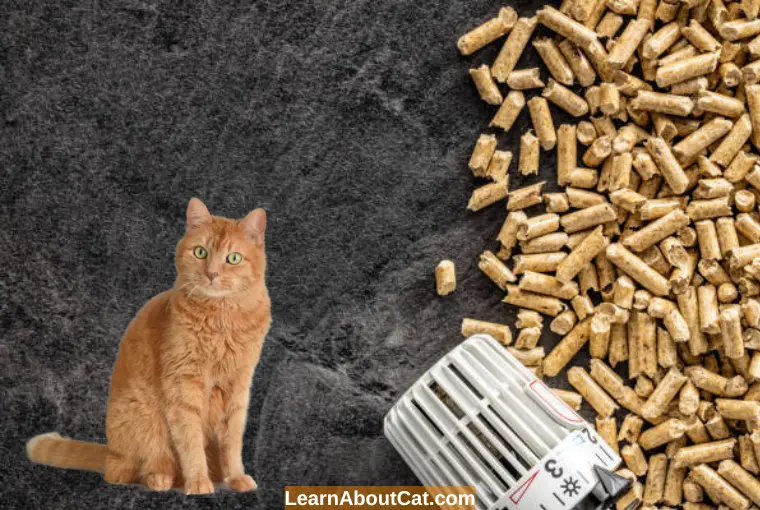
When the wood pellets are wet with pee, they don’t cluster; rather, they break down into debris. This strategy keeps the wooden pellets fresh and maintains optimum moisture content in pellets so that it always remains above while the powder particles settle at the base of the litter box. So, while cleaning the litter box, you have to clean the separated sawdust and, by reverse scooping, maintain the new pellets.
Wood pellets similarly react with excrement, just like conventional clay does. However, there might be a single difference which is unlike most wooden pellets, several sand litters attach to the cat’s poop and hide it.
While the majority of wood pellets don’t form clusters, some varieties can clump somewhat. These clumping wooden pellets are comparable to sand litter — you scrape out the faecal matter clumps and keep the remainder for use.
How to Scoop Wood Pellet Litter?
You may be thinking whether cleaning wood pellets is more difficult than cleaning regular dirt litter. In a way, picking urine-soaked pellets is the reverse of picking regular clump litter because the urine-soaked pellets often dissolve rather than cluster around.
It may require you to become adjusted at first, but when you do, removing this type of litter won’t be any more difficult. Here is a quick, step-by-step cleaning tutorial for normal litter boxes:
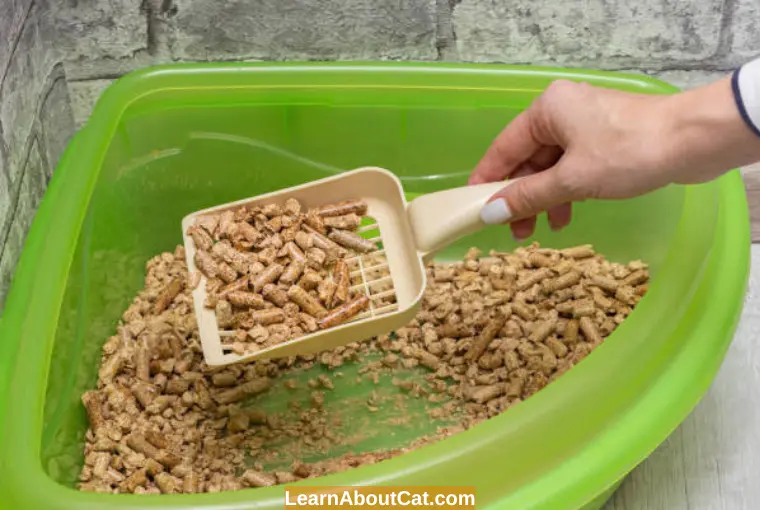
- Similar to how you do with regular litter, pick out all of the excrement and dispose of it in the garbage.
- Move your shovel over the trash can, collecting all the moist dust spots on it. By doing this, the debris will be disposed of while the new, complete wooden pellets which haven’t broken down will remain on the shovel.
- Throw all the gathered unbroken pellets directly into the tidy litter box rather than discarding the remains left on the shovel.
- To compensate for the quantity you’ve wasted, add additional pellets.
Additionally, you can stir the cat litter a little each day to ensure that the disintegrating debris settles at the boxes’ base and is replaced by new pellets.
Can I Flush Wood Pellet Litter Down the Toilet?
Although marketed as such, you should never flush cat litter down the toilet. Although wood pellets break down when contacted with moisture, they never completely disintegrate like waste or toilet paper does, making sawdust clog pipe systems and cause plumbing damage.
Not only that, cat waste is considered a pollutant. It can contain the harmful parasite Toxoplasma gondii, which is dangerous for pregnant and immunocompromised women. Our sewage systems do not sanitize waste from this parasite, leaving marine life and humans at risk.
Pros and Cons of Wood Pellet Cat Litter
This is a brief outline of the benefits and drawbacks of wood pellets in felines litter to assist you in making your decision.
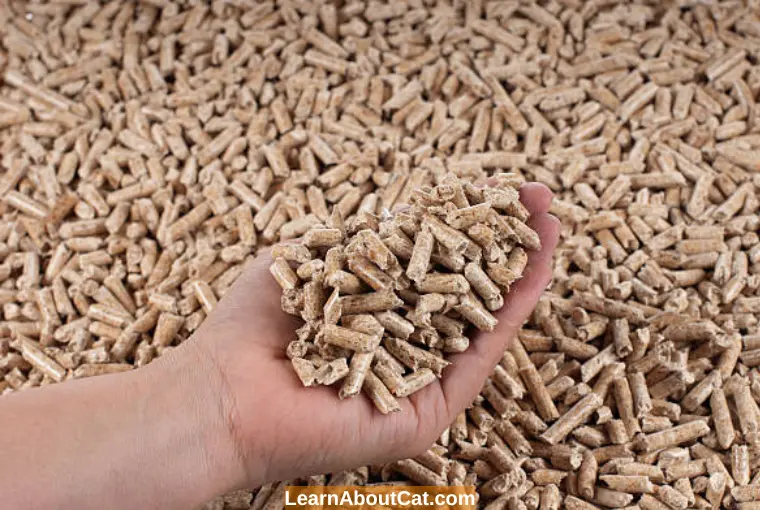
Pros
- Your feline won’t feel uncomfortable from having items lodged in her feet since it doesn’t adhere to her feet.
- It is ecological and disposable.
- Since conventional wood pellet doesn’t contain any additional odours or toxins, it is perfectly natural.
- Its recycling alternatives are practical and simple: Most varieties can be recycled or flushed into the toilet.
- Litters made of wood pellets are more lightweight than those made of regular clay.
- Your pet is quite secure around them. Although the likelihood of her doing so is quite less, your feline will be all right even when she does.
- Many litters made of wood pellets can be flushed.
- Its substance gives it a pleasant, fresh, rustic smell that aids in air filtration.
- Wooden pellets from most brands are usually dust-free, so it is perfect for felines and cat owners with sensitive respiratory systems.
- It can absorb urine more quickly than traditional sand and is perfect for removing ammonia odours.
Cons:
- Comparing ordinary clay to wood pellets, the latter results in a slight price hike.
- Since most cats like perfectly-grained texture in their litter, switching to wooden pellets may be challenging.
- For those who are familiar with picking clumping excrement, the idea that wood pellets don’t cluster may be a disadvantage.
- Some cats might not enjoy the wood fragrance, or they can be sensitive to the substance.
Other Natural Cat Litters
If you aren’t comfortable with using wood pellets as litter but want a natural alternative, you can consider several other options.
Natural litter is biodegradable and eco-friendly, so it will always be superior to clay litter made by strip mining. Your options are recycled paper, grass, wheat, corn, and walnut shell litter.
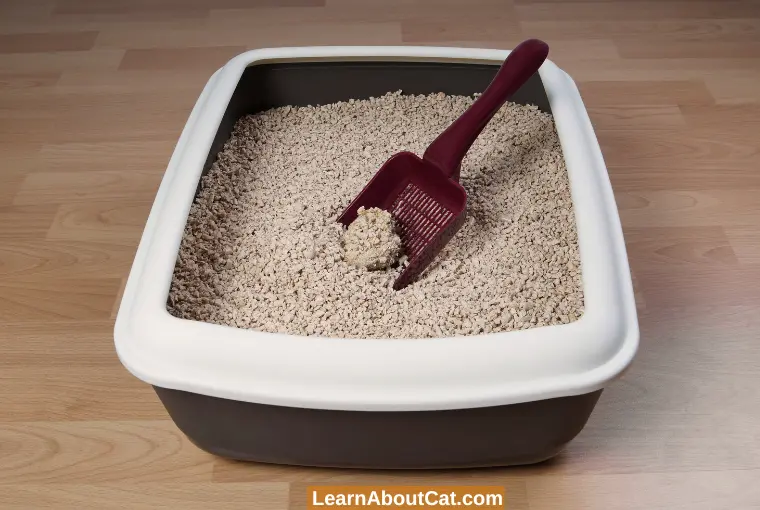
1. Recycled Paper Cat Litter
Recycled paper litter is made of recycled paper compressed into small cylindrical pellets. It is a fantastic eco-friendly, biodegradable, dust-free, and safe alternative. Texture-wise, it is the same as wood pellets. However, it is completely dust-free, even more dust-free than wood pellet litter, as sawdust from wood pellets can cause a minute amount of tracking. It is also non-toxic for felines and much more absorbable than clay litter.
One huge drawback, though, is how difficult it is to clean. Soiled pellets grow in sizes two to three times bigger than untouched pellets, and it may be difficult to separate them.
2. Walnut shell Cat Litter
Walnut shell cat litter is made of compressed walnut shells that were going to be disposed of anyway. Hence they make a great biodegradable, eco-friendly option.
Walnut shell cat litter can absorb up to three times more liquid than ordinary clay litter. It is granular in texture, meaning that it is similar to what cats are used to (dirt or clay). Due to its granular form, it can cause some tracking and dust. However, the dust caused by this litter is non-toxic, unlike clay litter which contains sodium bentonite.
The only disadvantage of this litter is that it can stain. It will stain the litter box a dark brown colour, and your floors, carpets, and surfaces will have this stain when carried from your cat’s paws.
3. Corn and Wheat Cat Litter
Corn and wheat litters are basically corn and wheat grains compacted into pellet formation; however, they clump when they touch moisture, unlike wood pellet litter. Corn and wheat litter is the best litter out there.
There really is nothing bad that can be said about this product. Not only is it super absorbent, but it also has excellent odour control. The corn kernels soak up moisture very rapidly, leaving a dry, pleasant-smelling litter box that your cat will never hesitate to use.
It is easy to clean because it clumps when it gets wet and is notorious for being completely dust-free. It is free of additives and scents, so it is non-toxic for cats.
Lastly, it is biodegradable and environmentally beneficial. The only drawback to this kind of litter is its price. However, with so many plus points this litter offers, we think it is worth the price.
4. Grass Cat Litter
Grass cat litter is very similar to corn and wheat litter in terms of advantages. It is made of grass seeds that clump together when wet. It is soft in nature, so it will be gentle on kittens, elderly cats, and injured cats’ paws.
This litter does track, however. It does not cause any dust and is completely non-toxic and safe in case your cat ingests some.
It is dust free, so allergies will no longer be a concern. It contains no additives or scents and is 100% natural. It also clumps when wet, so scooping it is easy. The only downside, again, is its cost.
Also, Check Out: What Can I Use Instead Of Cat Litter? Top 10 Alternatives
Clay and Silica Litter vs Natural Litter
Clay and silica litter are commercially manufactured of artificial products, meaning they are not biodegradable and eco-friendly like their counterparts. They are, nevertheless, more affordable and widely popular. The most frequently used form of litter is clay litter.
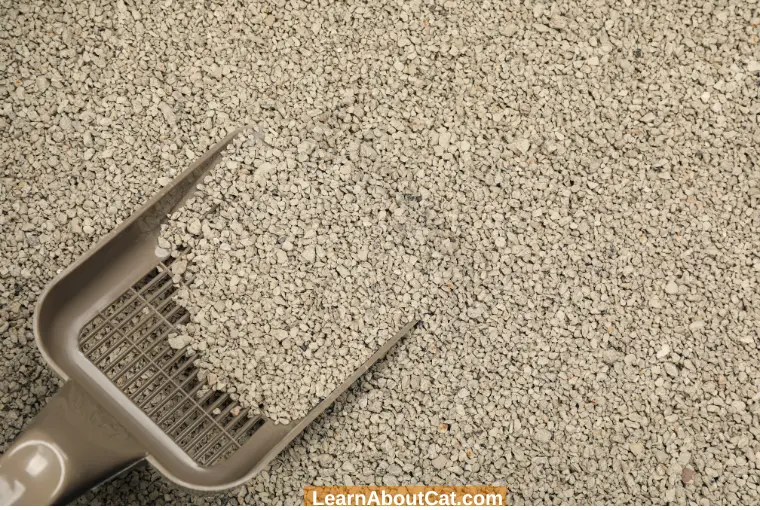
Clay Litter
There are two types of it: clumping and non-clumping. Fuller’s earth, which is used to make non-clumping clay litter, is very absorbent and odour-cancelling.
- Non-clumping clay litter is made of fuller earth, which means it is very absorbing and odour-cancelling. However, the entire box needs to be thrown out after use.
- Clumping clay litter is the most commonly used cat litter worldwide. It is very similar to dirt, which is what felines are biologically ingrained to use as litter, so they seem to enjoy the texture of clay litter. It clumps when it gets wet, so it can easily be separated. However, it contains sodium bentonite, a harmful component that will make your pet ill if inhaled or ingested too much. It also spreads dust and will be spread around by your cat’s paws. It is also no friend to the environment. Not only is it non-biodegradable, but it is also produced by strip mining, which is destructive to the environment.
Silica Gel Cat Litter
Silica gel cat litter is made of silicon beads that can absorb up to 40 times its weight. It does not clump, so you will need to change the entire box. However, it can absorb a lot of urine, so it will last a long time between changes.
As long as you remove solid waste, one batch can easily last you a week or two. Silica is also dust and tracking-free.
However, silica is harmful to cats and humans. If inhaled, it can cause lung disease silicosis in humans. If ingested by cats, it will build up in their bodies over time and become toxic.
Due to the fact that it is manufactured via sand mining, it is also harmful to the environment. Additionally, it is non-biodegradable, making it a pollutant that will accumulate over time.
Frequently Asked Questions
Does wood pellet cat litter reduce odor?
Yes, wood pellets contain a natural woody, pine-like odour that dissipates a mild, pleasant scent into the environment. Also, wood pellets break down when they absorb urine and turn into sawdust.
During the breakdown process, these pellets absorb ammonia from your cat’s urine, the compound responsible for the pungent smell of your cat’s business.
This property of wood pellets reduces the odour that may come from your feline’s litter.
Does wood pellet litter require a custom litter box?
You can utilize your existing litter box if you can’t buy a special one for wood pellets. Furthermore, it makes no difference if the litter box has a cover.
Although litter trays are made specifically for wooden pellets, they might prevent you from regular scooping and simplify the cleaning.
Are wood pellets good for cat litter?
Wood pellets are the ideal choice for cat litter. Not only are they biodegradable, but they also are non-toxic for your feline, spread zero dust and tracking, and are economical to purchase.
Are cats allergic to wood pellets?
Cedarwood cat litter can be irritating in texture and can cause atopic dermatitis in cats. Also, cats allergic to wood scrapings can also be allergic to wood pellets.
What type of wood is used in wood pellet cat litter?
Wood pellets are made from either softwood (pine or cedar wood) or hardwood (oak or apple wood).
Typically, wood pellet litter is made from pine, but sometimes it is made from cedar wood. A wood pellet is made by dehydrating and compressing the wood under high heat. These pellets are as effective as cat litter because of their impressive absorbency.
Which wood pellets are safe to use as cat litter?
Wood pellets marketed for cats and horse bedding (equine wood pellets) are safe to use as cat litter.
Wrap Up!
Wood pellets are non-toxic, economically friendly, biodegradable, dust and tracking-free. So there is really no reason why you should use clay litter when this option is available. Yes, it will take time for your cat to get used to wood pellet litter, but once it does, there’s no going back!
Related Posts:
Who is Isabella?
My name is Isabella, and I am a dedicated and knowledgeable cat enthusiast. With years of experience caring for cats and a deep love for felines, I made a mission to help other cat lovers navigate the challenges of cat ownership.

